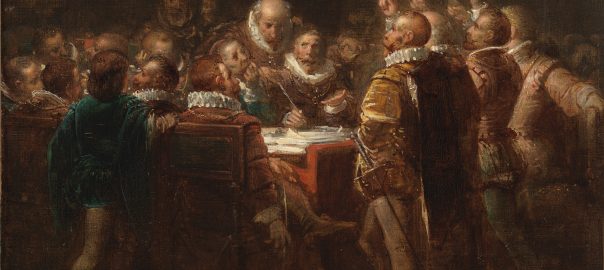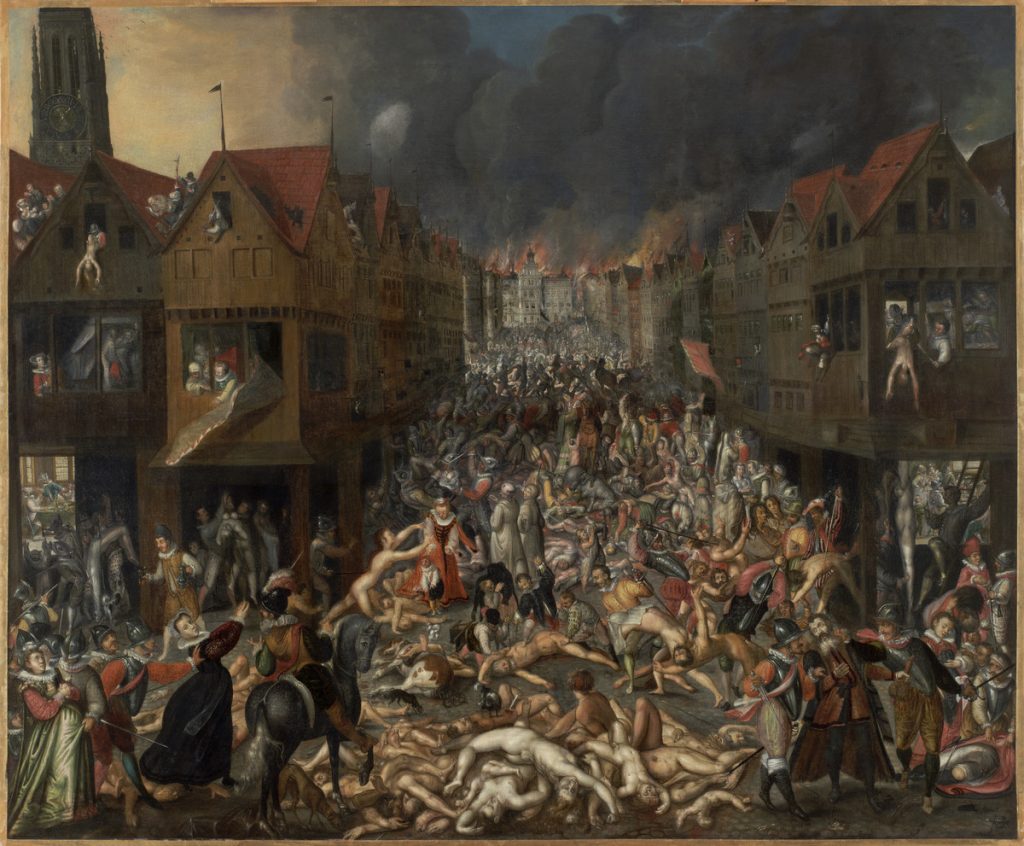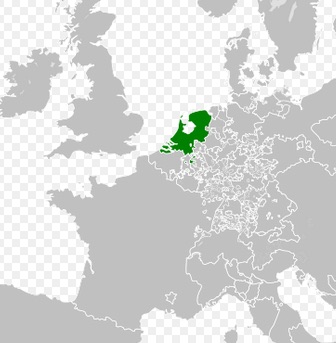The Spanish/Habsburgs had been facing a lot of dissent for some years by now, in the morphologically crumbly portions of the North Sea coast known generically as the Netherlands (the “lowlands”; note that this designation covered an area broader than that of today’s state of the Netherlands.) A large part of this dissent was theological, since there were many Protestants of various varieties in the Netherlands; but part of it was also localized resistance– including by Catholics of the area– against the autocratic, highly militarized rule of the distant Habsburgs.
Back in 1576, mercenaries fighting in the area for the Spanish, being unpaid, had decided to sack the very rich lowlands city of Antwerp in order to pay themselves from the takings. Antwerp had until then been the effective capital of the anti-Spanish movement in the Netherlands. The Spanish soldiers’ 1576 Sack of Antwerp killed 7,000 people in the city; and the soldiers stole or demolished much of its wealth.
(Interestingly, the reason the soldiers had been unpaid was because a Spanish ship carrying 400,000 florins intended for them had been captured en route by the English authorities…)
The Sack of Antwerp did not solve the problems that Philip II of Spain faced in the Netherlands. Indeed, it almost certainly exacerbated them, hardening the hearts against him of many in the wealthy Netherlands merchant class who might otherwise have been prepared to continue doing business with him.
The Habsburgs had never attempted to unify the seventeen or so territories that made up the Netherlands, keeping them as Duchies or Provinces or whatever but under the the central authority of the Habsburgs, as generally exercised by the King of Spain
… Thus, in July 1581, representatives of the seven northernmost (and most reliably rebellious) of these Netherlands territories came together at The Hague to adopt a document called the Act of Abjuration by which they “abjured” (set aside) the fealty previously required of them to the Habsburg monarch. These territories had previously been known as the Union of Utrecht.
After the Act of Abjuration, they formed themselves into a body called the Republic of the Seven United Netherlands— often known as the United Provinces. The republic was a confederation of provinces each with a high degree of independence from the federal assembly, known as the States General.
The Act of Abjuration “prohibited the use of the name and seal of Philip in all legal matters, and of his name or arms in minting coins. It gave authority to the Councils of the provinces to henceforth issue the commissions of magistrates. The Act relieved all magistrates of their previous oaths of allegiance to Philip, and prescribed a new oath of allegiance to the States (that is, the ‘assembly’) of the province in which they served.”
English-WP notes that,
The Act was remarkable for its extensive Preamble, which took the form of an ideological justification, phrased as an indictment (a detailed list of grievances) of King Philip. This form, to which the American Declaration of Independence bears striking resemblance, has given rise to speculations that Thomas Jefferson, when he was writing the latter, was at least partly inspired by the Act of Abjuration.
(The banner image above is a 19th century painting depicting the signing of the Act.)
The United Provinces of the Netherlands was the first republic to emerge in early-modern European history. Among its leading theorists was William the Silent (also called William of Orange), a rich guy from a deeply devout Protestant family, born in 1533, who as a child had inherited the Princedom of Orange from a childless cousin. However, the condition of his assuming this princedom was that he become a Catholic. King Charles of Spain (Philip’s father) had taken a great interest in the lad’s education. William became quite a favorite of Charles, who as he grew to adulthood appointed him to several high offices. But it seems that the anti-Protestant hatred shown by Charles and Philip pretty soon became too much for William, who slowly and carefully went over to the rebels’ side.
Though the UP’s of the Netherlands were apparently declared as a republic, in 1581 William thought they needed some kind of good, monarchical-ish representative to help them win foreign allies; and he recruited the Duke of Anjou, the younger brother of the King of France, for this role. But the Duke of Anjou was really bad at this new job and aroused considerable ire from the people, who essentially fired him. Then, an attempt to persuade England’s Queen Elizabeth to become their monarch did not succeed, so the States General asked William to become their king. However– getting ahead of ourselves a little here– in 1584, William was assassinated. The following year, Elizabeth “agreed to send aid to the Dutch rebels as their protector, though without assuming sovereignty.” She sent one of her earls to be Governor-General of the Netherlands– but, like the “reign” of the Duke of Anjou, this one also proved a disappointment.
In 1587, the States General decided to assume sovereignty themselves, thereby making the seven United Provinces truly a republic.
The war of the Netherlanders against Spanish overlordship went on for several decades after 1581, particularly in the southern parts of the Low Countries. But the regional leaders who met at The Hague to adopt the Act of Abjuration had laid a sturdy political/juridical basis that– along with their presumably strong ability to defend themselves from a Spanish naval assault– allowed Netherlanders to pursue an independent foreign policy, and especially an independent empire-building policy, over the decades that followed. They would, as we know, take full advantage of this opportunity.




